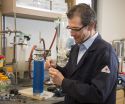Short-necked Triassic marine reptile discovered in China
Reptile found with broken digits, likely prior to death
2014-12-17
(Press-News.org) A new species of short-necked marine reptile from the Triassic period has been discovered in China, according to a study published December 17, 2014 in the open-access journal PLOS ONE by Xiao-hong Chen from Wuhan Centre of China Geological Survey and colleagues.
Hupehsuchia is a group of mysterious Triassic marine reptiles which have, so far, only been found in two counties in Hubei Province, China. The group is known by its modestly long neck, with nine to ten cervical vertebrae, but the authors of this study recently discovered a new species of Hupehsuchia that may show for the first time a species with a short neck (six cervical vertebrae), which they named Eohupehsuchus brevicollis. The left forelimb of this specimen is incomplete, ending with broken digits. Scientists suspect the breakage occurred pre-burial, possibly the result of a predator attack.
In addition to the short neck, the skull shape, with narrow forehead and parietal bones on the top of the head shifted back, are distinct and further support the need to name a new species. Analysis of related species led the researchers to believe that this new species forms the sister taxon of Hupehsuchidae.
INFORMATION:
In your coverage please use this URL to provide access to the freely available paper: http://dx.plos.org/10.1371/journal.pone.0115244
Citation: Chen X-h, Motani R, Cheng L, Jiang D-y Rieppel O (2014) A Small Short-Necked Hupehsuchian from the Lower Triassic of Hubei Province, China. PLoS ONE 9(12): e115244. doi:10.1371/journal.pone.0115244
Funding: This work was supported by the China Geological Survey Project 1212010611603 to Xiaohong Chen, the China Geological Survey Projects 1212011120148 to Long Cheng, and the National Natural Science Foundation of China Projects 40920124002 and 41372016 to Da-yong Jiang. The funders had no role in study design, data collection and analysis, decision to publish, or preparation of the manuscript
Competing Interests: The authors have declared that no competing interests exist.
[Attachments] See images for this press release:

ELSE PRESS RELEASES FROM THIS DATE:
2014-12-17
A network of nine reference sites off the Australian coast is providing the latest physical, chemical, and biological information to help scientists better understand Australia's coastal seas, according to a study published December 17, 2014 in the open-access journal PLOS ONE by Tim Lynch from CSIRO, Australia and colleagues.
Sustained oceanic observations allow scientists to track changes in oceanography and ecosystems. To address this, the Australian Integrated Marine Observing System (IMOS) implemented a network of nine National Reference Stations (NRS). The network ...
2014-12-17
Like human patients, mice with a form of Duchenne muscular dystrophy undergo progressive muscle degeneration and accumulate connective tissue as they age. Now, researchers at the Stanford University School of Medicine have found that the fault may lie at least partly in the stem cells that surround the muscle fibers.
They've found that during the course of the disease, the stem cells become less able to make new muscle and instead begin to express genes involved in the formation of connective tissue. Excess connective tissue -- a condition called fibrosis -- can accumulate ...
2014-12-17
Bird migration is an impressive phenomenon, but why birds often travel huge distances to and from their breeding grounds in the far North is still very unclear. Suggestions include that the birds profit from longer daylight hours, or that there are fewer predators. Researchers from the University of Groningen and the NIOO-KNAW Vogeltrekstation, the Dutch centre for bird migration and demographics, have discovered a new explanation.
They investigated barnacle geese breeding on Spitsbergen and compared them with birds of the same species that did not migrate but stayed ...
2014-12-17
DURHAM, N.C. -- The best way to protect wild spinner dolphins in Hawaii while also maintaining the local tourism industry that depends on them is through a combination of federal regulations and community-based conservation measures, finds a new study from Duke University.
Each year, hundreds of thousands of tourists to Hawaii pay to have up-close encounters with the animals, swimming with them in shallow bays the dolphins use as safe havens for daytime rest. But as the number of tours increases, so do the pressures they place on the resting dolphins.
The Duke study ...
2014-12-17
A new catalytic process is able to convert what was once considered biomass waste into lucrative chemical products that can be used in fragrances, flavorings or to create high-octane fuel for racecars and jets.
A team of researchers from Purdue University's Center for Direct Catalytic Conversion of Biomass to Biofuels, or C3Bio, has developed a process that uses a chemical catalyst and heat to spur reactions that convert lignin into valuable chemical commodities. Lignin is a tough and highly complex molecule that gives the plant cell wall its rigid structure.
Mahdi ...
2014-12-17
A close look at the night sky reveals that stars don't like to be alone; instead, they congregate in clusters, in some cases containing as many as several million stars. Until recently, the oldest of these populous star clusters were considered well understood, with the stars in a single group having formed at different times, over periods of more than 300 million years. Yet new research published online today in the journal Nature suggests that the star formation in these clusters is more complex.
Using data from the Hubble Space Telescope, a team of researchers at the ...
2014-12-17
OAK RIDGE, Tenn., Dec. 17, 2014--Scientists at the Department of Energy's Oak Ridge National Laboratory have used advanced microscopy to carve out nanoscale designs on the surface of a new class of ionic polymer materials for the first time. The study provides new evidence that atomic force microscopy, or AFM, could be used to precisely fabricate materials needed for increasingly smaller devices.
Polymerized ionic liquids have potential applications in technologies such as lithium batteries, transistors and solar cells because of their high ionic conductivity and unique ...
2014-12-17
UCLA researchers have developed a lens-free microscope that can be used to detect the presence of cancer or other cell-level abnormalities with the same accuracy as larger and more expensive optical microscopes.
The invention could lead to less expensive and more portable technology for performing common examinations of tissue, blood and other biomedical specimens. It may prove especially useful in remote areas and in cases where large numbers of samples need to be examined quickly.
The microscope is the latest in a series of computational imaging and diagnostic devices ...
2014-12-17
VIDEO:
It's official -- our holiday lights are so bright we can see them from space. Thanks to the VIIRS instrument on the Suomi NPP satellite, a joint mission between NASA...
Click here for more information.
Even from space, holidays shine bright.
With a new look at daily data from the NOAA/NASA Suomi National Polar-orbiting Partnership (Suomi NPP) satellite, a NASA scientist and colleagues have identified how patterns in nighttime light intensity change during major holiday ...
2014-12-17
The sun emitted a mid-level solar flare, peaking at 11:50 p.m. EST on Dec. 16, 2014. NASA's Solar Dynamics Observatory, which watches the sun constantly, captured an image of the event. Solar flares are powerful bursts of radiation. Harmful radiation from a flare cannot pass through Earth's atmosphere to physically affect humans on the ground, however -- when intense enough -- they can disturb the atmosphere in the layer where GPS and communications signals travel.
To see how this event may affect Earth, please visit NOAA's Space Weather Prediction Center at http://spaceweather.gov, ...
LAST 30 PRESS RELEASES:
[Press-News.org] Short-necked Triassic marine reptile discovered in China
Reptile found with broken digits, likely prior to death





